Recent Fire Damage Posts
Fire Extinguishers Best For You
2/13/2024 (Permalink)
Small incidental fires can begin at home for several reasons; a cigarette, a grease fire on the stovetop, a lit candle, or space heater left unattended. A small home fire can often be put out with a fire extinguisher, rather than calling the fire department. That, of course, depends on the size of the fire and the type of extinguisher you have. Ensuring you have the proper one for your property is necessary to ensure handling of a fire.
Get the Right Extinguisher
Part of fire preparedness is knowing which kind of fire extinguisher is best for certain fires. Understanding the difference is of great importance, as some can do more harm than good. The following list explains the difference.
Type A – Suitable for everyday combustibles such as paper, fabric, and wood
Type B – Works best for fuels like gasoline, butane, and cooking oils
Type C – A most appropriate choice for electrical fires
Additional Information
Not only do extinguishers have different types, but they have other variations besides. Type A and B have a number before the letter to designate their effectiveness. A 4-A works better on a paper fire than a 2-A. If the unit has a C but no number ahead of it, it means it will not conduct electricity. This is important to note for different environments and places within a property.
Which Extinguisher is Best?
The kind you decide to keep in your home depends on where you intend to keep it. You may decide you need more than one at hand for the greatest safety. For instance, you would do well to keep a type B in the kitchen where you are most likely to experience a grease fire. You might want to keep a type C near the breaker box and a type A near a bedroom, library, or craft room.
In the event, a larger blaze breaks out and you require more than a fire extinguisher, call 911 immediately. Then get help to assess the fire damage and manage fire cleanup, call the fire and water restoration service in Raytown, MO for help. They can handle the fire damage cleanup and help get things back to normal. Preparation can help you avoid a disaster, however, so keep a couple of extinguishers at hands and ensure you have the proper one(s) for your property!
Buying the Right Fire Extinguisher for Your Home
2/9/2023 (Permalink)
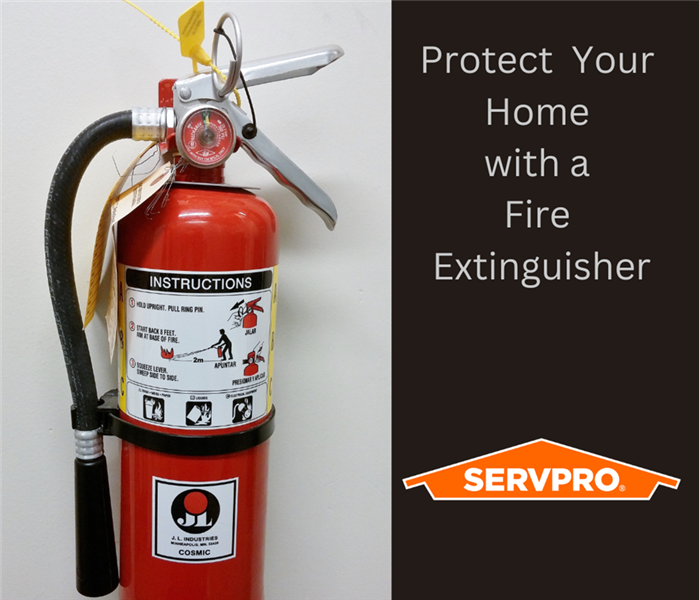 Protect your home today!
Protect your home today!
Buying a fire extinguisher for your home in Kansas City, MO can be confusing. There are so many options available that it’s hard to know which will work best for your family. The two main items to consider include the classification and the size of the unit.
Classification of Extinguishers
Household extinguishers are available in three classifications, or some combination of these, as identified on the label. The classification indicates which type of fire can be extinguished.
A - This class identifies ordinary combustibles like cloth, wood, or paper.
B - Flammable liquids like cooking oil, gasoline, and grease are identified in this classification.
C - Live electricity is handled most effectively with this class of extinguisher.
Many household fire extinguishers are classified with all three designations (A:B: C), which means that they can combat all three types of fires. Most units also include an identifying number directly preceding the letters. The higher the number, the more effective it will be to combat each type of home fire.
Sizes of Extinguishers
There are several sizes of extinguishers. The larger the unit, the more powerful it is. If it’s too heavy to handle, however, it won’t be of much use.
10 pound - This size is most suitable for a home workshop or garage. A rechargeable unit with a hose will make it more user-friendly.
5 pound - This unit can be stored easily under the kitchen sink or in the laundry room. The rechargeable model is the smartest option.
2 pound - This small extinguisher will fit nicely inside your car. The disposable unit comes equipped with a mount so that it will stay firmly in place inside your trunk.
Stovetop - This option can be mounted on your stove range’s hood. Just remember not to place it over a deep fryer.
No matter which unit you choose, it is important to include fire extinguisher training as part of your family’s fire preparedness.
Be Safer With a Home Fire Extinguisher
11/24/2022 (Permalink)
Small incidental fires can begin at home for several reasons; a cigarette, a grease fire on the stovetop, or a lit candle or space heater left unattended. A small home fire can often be put out with a fire extinguisher, rather than calling the fire department in Raytown, MO. That, of course, depends on the size of the fire and the type of extinguisher you have.
Get the Right Extinguisher
Part of fire preparedness is knowing which kind of fire extinguisher is best for certain fires. Understanding the difference is of great importance, as some can do more harm than good. The following list explains the difference.
Type A – Suitable for everyday combustibles such as paper, fabric, and wood
Type B – Works best for fuels like gasoline, butane, and cooking oils
Type C – A most appropriate choice for electrical fires
Additional Information
Not only do extinguishers have different types, but they have other variations besides. Type A and B have a number before the letter to designate their effectiveness. A 4-A works better on a paper fire than a 2-A. If the unit has a C but no number ahead of it, it means it will not conduct electricity.
Which Extinguisher is Best?
The kind you decide to keep in your home depends on where you intend to keep it. You may decide you need more than one at hand for the greatest safety. For instance, you would do well to keep a type B in the kitchen where you are most likely to experience a grease fire. You might want to keep a type C near the breaker box and a type A near a home den, library, or craft room.
In the event, a larger blaze breaks out and you require more than a fire extinguisher, call 911 immediately. Then get help to assess the fire damage and manage fire cleanup, call the fire and water restoration service in Raytown, MO for help. They can handle the fire damage cleanup and help get things back to normal. Preparation can help you avoid a disaster, however, so keep a couple of extinguishers at hand.
How to Reduce the Chance of a Kitchen Fire
7/29/2022 (Permalink)
Though fires can start in any area of the home, many fires often begin in kitchens, and kitchen fires can cause widespread damage to homes. Fortunately, there are various tips you can follow to help to reduce the chance of a kitchen fire occurring in your home.
1. Don't Leave Cooking Food Unattended
When cooking, it can be easy to become distracted. Though you may be tempted to leave your kitchen while cooking, however, this can result in a fire. Items left on a stovetop can burn and catch fire in a short period of time if high heat is used, and if you are out of the room when the fire begins, you may not be able to stop the fire from getting out of control. For these reasons, it's generally best to stay in the kitchen when cooking.
2. Clean Your Kitchen Often
When it comes to fire prevention tips, cleaning your kitchen can be beneficial. If grease has spilled on your stovetop or in your oven, or if you use a dirty, greasy pan, a fire can start quickly. A grease fire can be particularly dangerous because it can spread at an accelerated rate and cause major damage to your home. Cleaning your kitchen often, however, can reduce the likelihood of grease causing a fire.
3. Keep a Fire Extinguisher Nearby
Though a flame in a kitchen doesn't necessarily spell disaster if it is quickly extinguished, fires that aren't quickly controlled can cause devastation to homes. If a home has been affected by major fire damage, many homeowners find it helpful to contact emergency restoration services. However, the sooner you are able to extinguish a fire, the less likely it is that your home will sustain major damage. Having an ABC fire extinguisher (an extinguisher that can put out fires caused by trash, grease, or electricity) in your kitchen can be wise.
Since kitchen fires are incredibly common, knowing tips to prevent this type of fire can be useful to homeowners. Preventative methods can include remaining in your kitchen when cooking, frequently cleaning your kitchen, and keeping a fire extinguisher in your kitchen.
Five Methods to Quickly Extinguish a Fire
7/29/2022 (Permalink)
Oil can catch fire when cooking if frying food is left unattended, allowed to splatter, or heated to too high of a temperature. One of the most disastrous mistakes you can make when dealing with a grease fire is to try and use water to put out the flames as this will only make the fire spread. Instead, try any of the following five methods to quickly extinguish the fire before needing to call in the aid of the fire department and a fire cleanup company.
1. Turn Off the Heat
The first thing you should always do if grease catches fire while you are cooking is to turn off the heat. While you might be tempted to move the pot, leave it where it is.
2. Cover the Flames
If the fire is confined to a single pot or is only in a small area, covering it with an inflammable object like a metal lid can help put out the flames. Make sure not to use a glass lid that can shatter.
3. Baking Soda
If you have a large supply of baking soda on hand, dump as much as you can on the grease fire. The carbon dioxide released by baking soda helps to smother the fire.
4. Salt
Another effective way to put out a kitchen fire is to reach for the salt since it helps prevent the flames from accessing more oxygen. Typically, you require less salt to put out the fire than you need if using baking soda.
5. Fire Extinguisher
A fire extinguisher can be used as a last resort if you have one located nearby in your kitchen. Make sure to only use a Class B or K extinguisher to put out a fire caused by grease.
Experiencing a grease fire can be extremely frightening as the flames often spread quickly. Remember to put down the bucket of water and instead try one of these methods to safely extinguish the fire.
Why The Chemical Mercaptan is a Lifesaver
7/18/2022 (Permalink)
The gas that heats many homes and provides energy for water heaters and clothes dryers is colorless and odorless. If it leaks from pipes or hoses it creates a dangerous situation due to its extreme combustibility. To make gas more detectable, engineers have added the chemical mercaptan, making it easily identifiable by its sulfurous, rotten egg smell. It is hard to estimate how many times a gas fire has been prevented by this chemical.
When a homeowner smells mercaptan it is a sure sign that somewhere in your home there is a gas leak. When this happens, immediate steps should be taken to shut off the gas or at least get people and pets out of the home and call the fire department.
The Best Actions To Take With a Natural Gas Leak
Specific actions can reduce the likelihood of a gas fire in a home or apartment. The goal is to stop the gas leak or increase the safety of everyone in the home. Here are the most effective actions to take:
Check all the appliances that use natural gas, beginning with the stove since this is the most likely source. Many times burners do not light, or go out, allowing gas to leak into the home. If you can find the source of the leak and stop it the emergency is over.
Increase the ventilation of your home by opening windows and doors. This enables the gas to dissipate and not collect in a certain area, reducing the likelihood of a gas explosion.
Don't use electrical devices, or even turn on lights, as this could ignite the gas.
Evacuate the home and call in the fire department
The Best Way To Handle Fire Damage
Gas fire in your home is likely to cause soot and smoke damage and loss of property. Call in a fire remediation team that will respond quickly and clean up the damage in a professional manner.
4th of July Summer Safety Tips
7/18/2022 (Permalink)
The 4th of July is one of the best times of the year in Missouri. Many people get together to celebrate freedom, friends, and food. Unfortunately, the holiday can also be dangerous due to the different risks that are present. When trying to stay safe during the holiday, there are a few important safety tips to follow to protect yourself from harm.
Handle Fireworks with Caution
To prevent injuries and fires that are caused by fireworks in the community, certain precautions should be taken. Never allow small children to get near fireworks or handle them. Adults should be the only ones lighting off the fireworks and should do so on the ground at a safe distance from trees or other objects. Keep a fire extinguisher close by and avoid lighting more than one firework at the same time.
Grill Safely
Grilling can also cause fires when you’re spending time flipping hamburgers and hot dogs outdoors. Look for leaks, holes, and cracks in the grill before you start using it on the 4th of July. Avoid grilling indoors or in an enclosed area. This can cause a fire to start and will lead you to hire professionals such as SERVPRO of Raytown/East Kansas City to repair the damage. The grill should also be placed at least two feet away from the deck, branches, or the siding of the house.
Use a Pool Gate
Many people spend time in the pool cooling off from the warm temperatures in Missouri during the summer season. Keep it a safe activity by using a pool gate that will prevent children from getting into the water when they’re not supervised. Wireless outdoor sensors can also be installed to inform you if a child is near the pool. A first aid kit should also be on hand to tend to any injuries that can occur in the water. Kids should also use life jackets and floatation devices while swimming.
Practice Food Safety
Wash your hands and clean the surfaces where you plan to prep food for the holiday. All meat should be cooked with a thermometer used to ensure that it reaches the right temperature to avoid food-borne illness. All leftovers should be refrigerated after two hours and not left outside. Toss out anything that sits outside for too long.
When trying to have a safe and memorable 4th of July, there are several safety practices to follow. With the right caution used, you can protect your family from harm and enjoy the day.
Leading Causes of Fires - How to Avoid
6/10/2022 (Permalink)
Cooking is the leading cause of home fires & injuries in the U.S. Cooking fires often result from unattended cooking and human error, rather than mechanical failure of stoves or ovens. Although it is important to make sure your appliances are functioning properly and kept up to date, it is equally important to cook with caution and never get too comfortable in the kitchen.
Heating is the second leading cause of residential fires. However, heating fires are a larger problem in single-family homes than in apartments. Unlike apartments, the heating systems in single-family homes are often not professionally maintained. Make sure your heating systems are being professionally regulated during the colder seasons.
Although accidents happen, it is important to be prepared and alert in order to minimize these chances before they occur. Here are a few simple safety precautions to take to decrease the possibility of a fire.
- Keep flammables away from ignition sources.
- Utilize flammable storage cabinets.
- Know your chemical properties.
- Do not block fire extinguishers with equipment.
- Utilize those with electrical expertise/installations/assistance.
- Do not overload outlets - use a track plug.
- Practice good housekeeping techniques in the lab/office/work area.
- Inspect wires for possible damage and replace them as needed.
Buying The Right Fire Extinguisher
2/24/2022 (Permalink)
Buying a fire extinguisher for your home in Kansas City, MO can be confusing. There are so many options available that it’s hard to know which will work best for your family. The two main items to consider include the classification and the size of the unit.
Classification of Extinguishers
Household extinguishers are available in three classifications, or some combination of these, as identified on the label. The classification indicates which type of fire can be extinguished.
A - This class identifies ordinary combustibles like cloth, wood, or paper.
B - Flammable liquids like cooking oil, gasoline, and grease are identified in this classification.
C - Live electricity is handled most effectively with this class of extinguisher.
Many household fire extinguishers are classified with all three designations (A:B: C), which means that they can combat all three types of fires. Most units also include an identifying number directly preceding the letters. The higher the number, the more effective it will be to combat each type of home fire.
Sizes of Extinguishers
There are several sizes of extinguishers. The larger the unit, the more powerful it is. If it’s too heavy to handle, however, it won’t be of much use.
10 pound - This size is most suitable for a home workshop or garage. A rechargeable unit with a hose will make it more user-friendly.
5 pound - This unit can be stored easily under the kitchen sink or in the laundry room. The rechargeable model is the smartest option.
2 pound - This small extinguisher will fit nicely inside your car. The disposable unit comes equipped with a mount so that it will stay firmly in place inside your trunk.
Stovetop - This option can be mounted on your stove range’s hood. Just remember not to place it over a deep fryer.
No matter which unit you choose, it is important to include fire extinguisher training as part of your family’s fire preparedness.
Be Safer With a Home Fire Extinguisher
11/24/2021 (Permalink)
Small incidental fires can begin at home for several reasons; a cigarette, a grease fire on the stovetop, or a lit candle or space heater left unattended. A small home fire can often be put out with a fire extinguisher, rather than calling the fire department in Raytown, MO. That, of course, depends on the size of the fire and the type of extinguisher you have.
Get the Right Extinguisher
Part of fire preparedness is knowing which kind of fire extinguisher is best for certain fires. Understanding the difference is of great importance, as some can do more harm than good. The following list explains the difference.
Type A – Suitable for everyday combustibles such as paper, fabric, and wood
Type B – Works best for fuels like gasoline, butane, and cooking oils
Type C – A most appropriate choice for electrical fires
Additional Information
Not only do extinguishers have different types, but they have other variations besides. Type A and B have a number before the letter to designate its effectiveness. A 4-A works better on a paper fire than a 2-A. If the unit has a C but no number ahead of it, it means it will not conduct electricity.
Which Extinguisher is Best?
The kind you decide to keep in your home depends on where you intend to keep it. You may decide you need more than one at hand for the greatest safety. For instance, you would do well to keep a type B in the kitchen where you are most likely to experience a grease fire. You might want to keep a type C near the breaker box and a type A near a home den, library, or craft room.
In the event, a larger blaze breaks out and you require more than a fire extinguisher, call 911 immediately. Then get help to assess the fire damage and manage fire cleanup, call the fire and water restoration service in Raytown, MO for help. They can handle the fire damage cleanup and help get things back to normal. Preparation can help you avoid a disaster, however, so keep a couple of extinguishers at hand.
How To Reduce the Chance of a Kitchen Fire
7/29/2021 (Permalink)
Though fires can start in any area of the home, many fires often begin in kitchens, and kitchen fires can cause widespread damage to homes. Fortunately, there are various tips you can follow to help to reduce the chance of a kitchen fire occurring in your home.
1. Don't Leave Cooking Food Unattended
When cooking, it can be easy to become distracted. Though you may be tempted to leave your kitchen while cooking, however, this can result in a fire. Items left on a stovetop can burn and catch fire in a short period of time if high heat is used, and if you are out of the room when the fire begins, you may not be able to stop the fire from getting out of control. For these reasons, it's generally best to stay in the kitchen when cooking.
2. Clean Your Kitchen Often
When it comes to fire prevention tips, cleaning your kitchen can be beneficial. If grease has spilled on your stovetop or in your oven, or if you use a dirty, greasy pan, a fire can start quickly. A grease fire can be particularly dangerous because it can spread at an accelerated rate and cause major damage to your home. Cleaning your kitchen often, however, can reduce the likelihood of grease causing a fire.
3. Keep a Fire Extinguisher Nearby
Though a flame in a kitchen doesn't necessarily spell disaster if it is quickly extinguished, fires that aren't quickly controlled can cause devastation to homes. If a home has been affected by major fire damage, many homeowners find it helpful to contact emergency restoration services. However, the sooner you are able to extinguish a fire, the less likely it is that your home will sustain major damage. Having an ABC fire extinguisher (an extinguisher that can put out fires caused by trash, grease, or electricity) in your kitchen can be wise.
Since kitchen fires are incredibly common, knowing tips to prevent this type of fire can be useful to homeowners. Preventative methods can include remaining in your kitchen when cooking, frequently cleaning your kitchen, and keeping a fire extinguisher in your kitchen.
Five Methods to Quickly Extinguish a Fire
7/29/2021 (Permalink)
Oil can catch fire when cooking if frying food is left unattended, allowed to splatter, or heated to too high of a temperature. One of the most disastrous mistakes you can make when dealing with a grease fire is to try and use water to put out the flames as this will only make the fire spread. Instead, try any of the following five methods to quickly extinguish the fire before needing to call in the aid of the fire department and a fire cleanup company.
1. Turn Off the Heat
The first thing you should always do if grease catches fire while you are cooking is to turn off the heat. While you might be tempted to move the pot, leave it where it is.
2. Cover the Flames
If the fire is confined to a single pot or is only in a small area, covering it with an inflammable object like a metal lid can help put out the flames. Make sure not to use a glass lid that can shatter.
3. Baking Soda
If you have a large supply of baking soda on hand, dump as much as you can on the grease fire. The carbon dioxide released by baking soda helps to smother the fire.
4. Salt
Another effective way to put out a kitchen fire is to reach for the salt since it helps prevent the flames from accessing more oxygen. Typically, you require less salt to put out the fire than you need if using baking soda.
5.Fire Extinguisher
A fire extinguisher can be used as a last resort if you have one located nearby in your kitchen. Make sure to only use a Class B or K extinguisher to put out a fire caused by grease.
Experiencing a grease fire can be extremely frightening as the flames often spread quickly. Remember to put down the bucket of water and instead try one of these methods to safely extinguish the fire.
4th of July Summer Safety Tips
7/17/2021 (Permalink)
The 4th of July is one of the best times of the year in Missouri. Many people get together to celebrate freedom, friends, and food. Unfortunately, the holiday can also be dangerous due to different risks that are present. When trying to stay safe during the holiday, there are a few important safety tips to follow to protect yourself from harm.
Handle Fireworks with Caution
To prevent injuries and fires that are caused by fireworks in the community, certain precautions should be taken. Never allow small children to get near fireworks or handle them. Adults should be the only ones lighting off the fireworks and should do so on the ground at a safe distance from trees or other objects. Keep a fire extinguisher close by and avoid lighting more than one firework at the same time.
Grill Safely
Grilling can also cause fires when you’re spending time flipping hamburgers and hot dogs outdoors. Look for leaks, holes, and cracks in the grill before you start using it on the 4th of July. Avoid grilling indoors or in an inclosed area. This can cause a fire to start and will lead to you to hire professionals such as SERVPRO of Raytown/East Kansas City to repair the damage. The grill should also be placed at least two feet away from the deck, branches, or the siding of the house.
Use a Pool Gate
Many people spend time in the pool cooling off from the warm temperatures in Missouri during the summer season. Keep it a safe activity by using a pool gate that will prevent children from getting into the water when they’re not supervised. Wireless outdoor sensors can also be installed to inform you if a child is near the pool. A first aid kit should also be on hand to tend to any injuries that can occur in the water. Kids should also use life jackets and floatation devices while swimming.
Practice Food Safety
Wash hands and clean the surfaces where you plan to prep food on the holiday. All meat should be cooked with a thermometer used to ensure that it reaches the right temperature to avoid food-borne illness. All leftovers should be refrigerated after two hours and not left outside. Toss out anything that sits outside for too long.
When trying to have a safe and memorable 4th of July, there are several safety practices to follow. With the right caution used, you can protect your family from harm and enjoy the day.
Why The Chemical Mercaptan Is a Lifesaver
7/17/2021 (Permalink)
The gas that heats many homes and provides energy for water heaters and clothes dryers is colorless and odorless. If it leaks from pipes or hoses it creates a dangerous situation due to its extreme combustibility. To make gas more detectable, engineers have added the chemical mercaptan, making it easily identifiable by its sulfurous, rotten egg smell. It is hard to estimate how many times a gas fire has been prevented by this chemical.
When a homeowner smells mercaptan it is a sure sign that somewhere in your home there is a gas leak. When this happens, immediate steps should be taken to shut off the gas or at least get people and pets out of the home and call the fire department.
The Best Actions To Take With a Natural Gas Leak
Specific actions can reduce the likelihood of a gas fire in a home or apartment. The goal is to stop the gas leak or increase the safety of everyone in the home. Here are the most effective actions to take:
Check all the appliances that use natural gas, beginning with the stove since this is the most likely source. Many times burners do not light, or go out, allowing gas to leak into the home. If you can find the source of the leak and stop it the emergency is over.
Increase the ventilation of your home by opening windows and doors. This enables the gas to dissipate and not collect in a certain area, reducing the likelihood of a gas explosion.
Don't use electrical devices, or even turn on lights, as this could ignite the gas.
Evacuate the home and call in the fire department
The Best Way To Handle Fire Damage
A gas fire in your home is likely to cause soot and smoke damage and loss of property. Call in a fire remediation team that will respond quickly and clean up the damage in a professional manner.
Leading Causes of Fires - How to Avoid
6/10/2021 (Permalink)
Cooking is the leading cause of home fires & injuries in the U.S. Cooking fires often result from unattended cooking and human error, rather than mechanical failure of stoves or ovens. Although it is important to make sure your appliances are functioning properly and kept up to date, it is equally important to cook with caution and never get too comfortable in the kitchen.
Heating is the second leading cause of residential fires. However, heating fires are a larger problem in single family homes than in apartments. Unlike apartments, the heating systems in single family homes are often not professionally maintained. Make sure your heating systems are being professionally regulated during the colder seasons.
Although accidents happen, it is important to be prepared and alert in order to minimize these chances before they occur. Here are a few simple safety precautions to take to decrease the possibility of a fire.
- Keep flammables away from ignition sources.
- Utilize flammable storage cabinets.
- Know your chemical properties.
- Do not block fire extinguishers with equipment.
- Utilize those with electrical expertise/installations/assistance.
- Do not overload outlets - use a track plug.
- Practice good housekeeping techniques in the lab/office/work area.
- Inspect wires for possible damage and replace as needed.
Buying the Right Fire Extinguisher
2/24/2021 (Permalink)
Buying a fire extinguisher for your home in Kansas City, MO can be confusing. There are so many options available that it’s hard to know which will work best for your family. The two main items to consider include the classification and the size of the unit.
Classification of Extinguishers
Household extinguishers are available in three classifications, or some combination of these, as identified on the label. The classification indicates which type of fire can be extinguished.
A - This class identifies ordinary combustibles like cloth, wood, or paper.
B - Flammable liquids like cooking oil, gasoline, and grease are identified in this classification.
C - Live electricity is handled most effectively with this class of extinguisher.
Many household fire extinguishers are classified with all three designations (A:B: C), which means that they can combat all three types of fires. Most units also include an identifying number directly preceding the letters. The higher the number, the more effective it will be to combat each type of home fire.
Sizes of Extinguishers
There are several sizes of extinguishers. The larger the unit, the more powerful it is. If it’s too heavy to handle, however, it won’t be of much use.
10 pound - This size is most suitable for a home workshop or garage. A rechargeable unit with a hose will make it more user-friendly.
5 pound - This unit can be stored easily under the kitchen sink or in the laundry room. The rechargeable model is the smartest option.
2 pound - This small extinguisher will fit nicely inside your car. The disposable unit comes equipped with a mount so that it will stay firmly in place inside your trunk.
Stovetop - This option can be mounted on your stove range’s hood. Just remember not to place it over a deep fryer.
No matter which unit you choose, it is important to include fire extinguisher training as part of your family’s fire preparedness.
Be Safer With a Home Fire Extinguisher
11/24/2020 (Permalink)
Small incidental fires can begin at home for several reasons; a cigarette, a grease fire on the stovetop, or a lit candle or space heater left unattended. A small home fire can often be put out with a fire extinguisher, rather than calling the fire department in Raytown, MO. That, of course depends on the size of the fire and the type of extinguisher you have.
Get the Right Extinguisher
Part of fire preparedness is knowing which kind of fire extinguisher is best for certain fires. Understanding the difference is of great importance, as some can do more harm than good. The following list explains the difference.
Type A – Suitable for everyday combustibles such as paper, fabric and wood
Type B – Works best for fuels like gasoline, butane and for cooking oils
Type C – Most appropriate choice for electrical fires
Additional Information
Not only do extinguisher have different types, but they have other variations besides. Type A and B have a number before the letter to designate its effectiveness. A 4-A works better on a paper fire than a 2-A. If the unit has a C but no number ahead of it, it means it will not conduct electricity.
Which Extinguisher is Best?
The kind you decide to keep in your home depends on where you intend to keep it. You may decide you need more than one at hand for the greatest safety. For instance, you would do well to keep a type B in the kitchen where you are most likely to experience a grease fire. You might want to keep a type C near the breaker box and a type A near a home den, library or craft room.
In the event a larger blaze breaks out and you require more than a fire extinguisher, call 911 immediately. Then get help to assess fire damage and manage fire cleanup, call the fire and water restoration service in Raytown, MO for help. They can handle the fire damage cleanup and help get things back to normal. Preparation can help you avoid a disaster however, so keep a couple extinguishers at hand.
Firework Safety
7/30/2020 (Permalink)
A holiday weekend like the Fourth of July brings much fun, but can also lead to disaster if the right precautions are not taken. Here a few quick and helpful tips to stay safe and enjoy your holiday.
- Never hold lighted fireworks in your hands
- Never light fireworks indoors
- Keep fireworks away from houses and flammable material
- Never point or throw fireworks toward another person
- Only light one device at a time
- Maintain a safe distance after lighting a firework
Although sparklers are a simple and fun firework for kids to use, they can still be quite dangerous if not handled properly. Sparkles can quickly ignite clothing, and children have received severe burns from dropping sparklers on their feet. Sparkles are not advised to children under the age of five, unless accompanied by and adult. Consider using safer alternatives, such as glow sticks, confetti poppers, or colored streamers for children when trying to celebrate safely this Fourth of July!
How to Reduce the Chance of a Kitchen Fire
7/28/2020 (Permalink)
Though fires can start in any area of the home, many fires often begin in kitchens, and kitchen fires can cause widespread damage to homes. Fortunately, there are various tips you can follow to help to reduce the chance of a kitchen fire occurring in your home.
1. Don't Leave Cooking Food Unattended
When cooking, it can be easy to become distracted. Though you may be tempted to leave your kitchen while cooking, however, this can result in a fire. Items left on a stovetop can burn and catch fire in a short period of time if high heat is used, and if you are out of the room when the fire begins, you may not be able to stop the fire from getting out of control. For these reasons, it's generally best to stay in the kitchen when cooking.
2. Clean Your Kitchen Often
When it comes to fire prevention tips, cleaning your kitchen can be beneficial. If grease has spilled on your stovetop or in your oven, or if you use a dirty, greasy pan, a fire can start quickly. A grease fire can be particularly dangerous because it can spread at an accelerated rate and cause major damage to your home. Cleaning your kitchen often, however, can reduce the likelihood of grease causing a fire.
3. Keep a Fire Extinguisher Nearby
Though a flame in a kitchen doesn't necessarily spell disaster if it is quickly extinguished, fires that aren't quickly controlled can cause devastation to homes. If a home has been affected by major fire damage, many homeowners find it helpful to contact emergency restoration services. However, the sooner you are able to extinguish a fire, the less likely that your home will sustain major damage. Having an ABC fire extinguisher (an extinguisher that can put out fires caused by trash, grease or electricity) in your kitchen can be wise.
Since kitchen fires are incredibly common, knowing tips to prevent this type of fire can be useful to homeowners. Preventative methods can include remaining in your kitchen when cooking, frequently cleaning your kitchen and keeping a fire extinguisher in your kitchen.
Five Methods to Quickly Extinguish a Fire
7/28/2020 (Permalink)
Oil can catch fire when cooking if frying food is left unattended, allowed to splatter, or heated to too high of a temperature. One of the most disastrous mistakes you can make when dealing with a grease fire is to try and use water to put out the flames as this will only make the fire spread. Instead, try any of the following five methods to quickly extinguish the fire before needing to call in the aid of the fire department and a fire cleanup company.
1. Turn Off the Heat
The first thing you should always do if grease catches fire while you are cooking is to turn off the heat. While you might be tempted to move the pot, leave it where it is.
2. Cover the Flames
If the fire is confined to a single pot or is only in a small area, covering it with an inflammable object like a metal lid can help put out the flames. Make sure not to use a glass lid that can shatter.
3. Baking Soda
If you have a large supply of baking soda on hand, dump as much as you can on the grease fire. The carbon dioxide released by baking soda helps to smother the fire.
4. Salt
Another effective way to put out a kitchen fire is to reach for the salt since it helps prevent the flames from accessing more oxygen. Typically, you require less salt to put out the fire than you need if using baking soda.
5.Fire Extinguisher
A fire extinguisher can be used as a last resort if you have one located nearby in your kitchen. Make sure to only use a Class B or K extinguisher to put out a fire caused by grease.
Experiencing a grease fire can be extremely frightening as the flames often spread quickly. Remember to put down the bucket of water and instead try one of these methods to safely extinguish the fire.
Leading Causes of Fires - How to Avoid
5/19/2020 (Permalink)
Cooking is the leading cause of home fires & injuries in the U.S. Cooking fires often result from unattended cooking and human error, rather than mechanical failure of stoves or ovens. Although it is important to make sure your appliances are functioning properly and kept up to date, it is equally important to cook with caution and never get too comfortable in the kitchen.
Heating is the second leading cause of residential fires. However, heating fires are a larger problem in single family homes than in apartments. Unlike apartments, the heating systems in single family homes are often not professionally maintained. Make sure your heating systems are being professionally regulated during the colder seasons.
Although accidents happen, it is important to be prepared and alert in order to minimize these chances before they occur. Here are a few simple safety precautions to take to decrease the possibility of a fire.
- Keep flammables away from ignition sources.
- Utilize flammable storage cabinets.
- Know your chemical properties.
- Do not block fire extinguishers with equipment.
- Utilize those with electrical expertise/installations/assistance.
- Do not overload outlets - use a track plug.
- Practice good housekeeping techniques in the lab/office/work area.
- Inspect wires for possible damage and replace as needed.
Buying the Right Fire Extinguisher
2/24/2020 (Permalink)
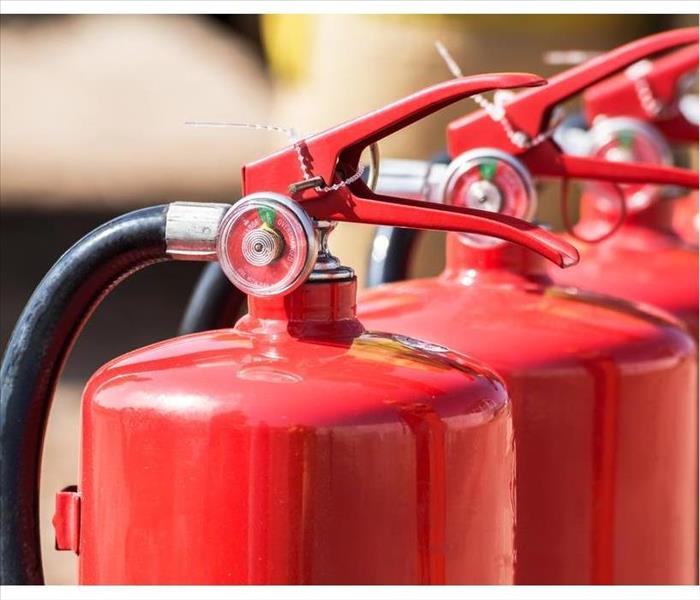 Buying a fire extinguisher for your home in Kansas City, MO can be confusing
Buying a fire extinguisher for your home in Kansas City, MO can be confusing
Buying a fire extinguisher for your home in Kansas City, MO can be confusing. There are so many options available that it’s hard to know which will work best for your family. The two main items to consider include the classification and the size of the unit.
Classification of Extinguishers
Household extinguishers are available in three classifications, or some combination of these, as identified on the label. The classification indicates which type of fire can be extinguished.
A - This class identifies ordinary combustibles like cloth, wood or paper.
B - Flammable liquids like cooking oil, gasoline and grease are identified in this classification.
C - Live electricity is handled most effectively with this class of extinguisher.
Many household fire extinguishers are classified with all three designations (A:B:C), which means that they can combat all three types of fires. Most units also include an identifying number directly preceding the letters. The higher the number, the more effective it will be to combat each type of home fire.
Sizes of Extinguishers
There are several sizes of extinguishers. The larger the unit, the more powerful it is. If it’s too heavy to handle, however, it won’t be of much use.
10 pound - This size is most suitable for a home workshop or garage. A rechargeable unit with a hose will make it more user-friendly.
5 pound - This unit can be stored easily under the kitchen sink or in the laundry room. The rechargeable model is the smartest option.
2 pound - This small extinguisher will fit nicely inside your car. The disposable unit comes equipped with a mount so that it will stay firmly in place inside your trunk.
Stove top - This option can be mounted on your stove range’s hood. Just remember not to place it over a deep fryer.
No matter which unit you choose, it is important to include fire extinguisher training as part of your family’s fire preparedness.
Be Safer With a Home Fire Extinguisher
11/24/2019 (Permalink)
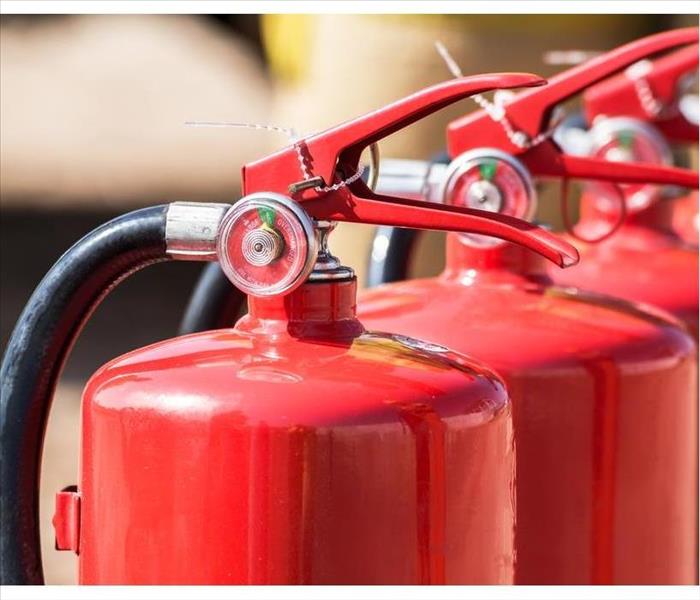 Preparation can help you avoid a disaster however, so keep a couple extinguishers at hand
Preparation can help you avoid a disaster however, so keep a couple extinguishers at hand
Be Safer With a Home Fire Extinguisher
Small incidental fires can begin at home for several reasons; a cigarette, a grease fire on the stovetop, or a lit candle or space heater left unattended. A small home fire can often be put out with a fire extinguisher, rather than calling the fire department in Raytown, MO. That, of course depends on the size of the fire and the type of extinguisher you have.
Get the Right Extinguisher
Part of fire preparedness is knowing which kind of fire extinguisher is best for certain fires. Understanding the difference is of great importance, as some can do more harm than good. The following list explains the difference.
Type A – Suitable for everyday combustibles such as paper, fabric and wood
Type B – Works best for fuels like gasoline, butane and for cooking oils
Type C – Most appropriate choice for electrical fires
Additional Information
Not only do extinguisher have different types, but they have other variations besides. Type A and B have a number before the letter to designate its effectiveness. A 4-A works better on a paper fire than a 2-A. If the unit has a C but no number ahead of it, it means it will not conduct electricity.
Which Extinguisher is Best?
The kind you decide to keep in your home depends on where you intend to keep it. You may decide you need more than one at hand for the greatest safety. For instance, you would do well to keep a type B in the kitchen where you are most likely to experience a grease fire. You might want to keep a type C near the breaker box and a type A near a home den, library or craft room.
In the event a larger blaze breaks out and you require more than a fire extinguisher, call 911 immediately. Then get help to assess fire damage and manage fire cleanup, call the fire and water restoration service in Raytown, MO for help. They can handle the fire damage cleanup and help get things back to normal. Preparation can help you avoid a disaster however, so keep a couple extinguishers at hand.
3 Steps To Take If You Suspect a Gas Leak
10/12/2019 (Permalink)
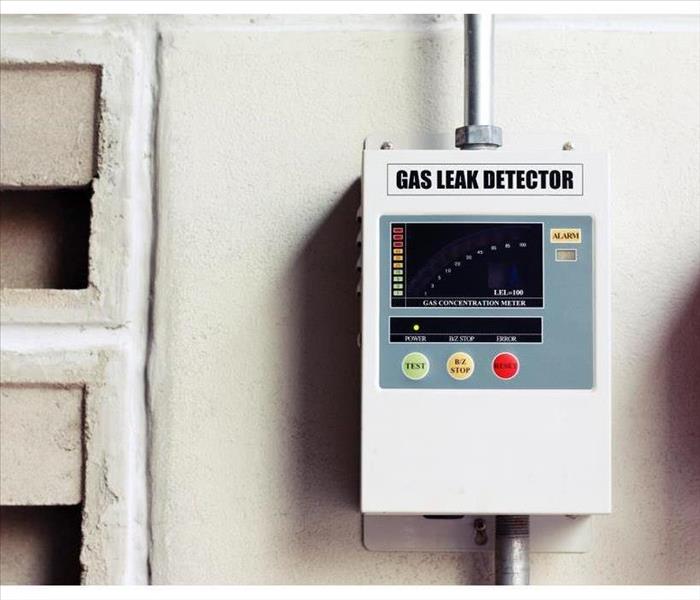 Take three steps to avoid a gas fire in your home
Take three steps to avoid a gas fire in your home
Act Quickly To Avoid a Gas Fire
If you notice a smell similar to rotten eggs or hear a hissing noise in your home in Raytown, MO, then you likely have a gas leak on your hands. To prevent a gas fire from breaking out, quickly take the following three steps.
1. Turn Off the Gas Source
If the smell of gas is very faint, you should try to turn off the source of the leak to prevent a gas explosion. Many times, the leak is coming from a home appliance such as a gas stove, fireplace, water heater, or boiler. If you are certain the gas if coming from one of these, you can often stop the leak directly at the appliance. If you are unable to determine the source, you will need to find your home’s gas meter and turn off the main natural gas shut-off.
2. Ventilate The House
After you’ve successfully turned off the source, you need to ventilate any remaining gas by opening all the windows and doors in the house to allow fresh air in. Do not try to turn on fans, lights, or any other electronics during this process since this can start a gas fire. If necessary, grab a flashlight to help you.
3. Evacuate and Call for Help
If at any point the rotten egg smell seems very strong or you feel unsafe, exit your home immediately in case of a gas explosion. As soon as you are a good distance away from your house, call for help. You can call 911 or dial your utility company’s emergency number. If there is any sign of a fire, you also need to get in contact with a professional fire restoration company to deodorize your home and address any damage.
If you think you smell natural gas leaking in your home, always act quickly to avoid a gas fire. Whether you have time to shut off the gas or need to leave immediately, make sure to prioritize your safety.
5 Ways to Put Out a Grease Fire
7/16/2019 (Permalink)
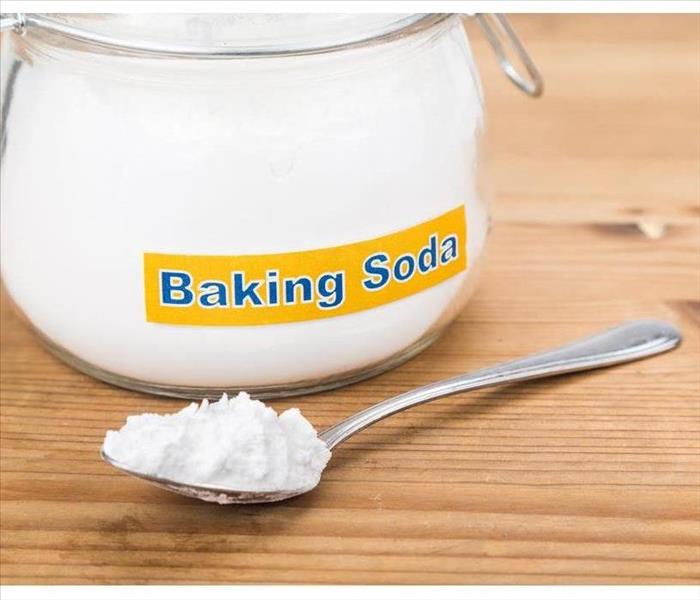 If you have a large supply of baking soda on hand, dump as much as you can on the grease fire
If you have a large supply of baking soda on hand, dump as much as you can on the grease fire
Five Methods to Quickly Extinguish a Fire
Oil can catch fire when cooking if frying food is left unattended, allowed to splatter, or heated to too high of a temperature. One of the most disastrous mistakes you can make when dealing with a grease fire in Unity Village, MO, is to try and use water to put out the flames as this will only make the fire spread. Instead, try any of the following five methods to quickly extinguish the fire before needing to call in the aid of the fire department and a fire cleanup company.
1. Turn Off the Heat
The first thing you should always do if grease catches fire while you are cooking is to turn off the heat. While you might be tempted to move the pot, leave it where it is.
2. Cover the Flames
If the fire is confined to a single pot or is only in a small area, covering it with an inflammable object like a metal lid can help put out the flames. Make sure not to use a glass lid that can shatter.
3. Baking Soda
If you have a large supply of baking soda on hand, dump as much as you can on the grease fire. The carbon dioxide released by baking soda helps to smother the fire.
4. Salt
Another effective way to put out a kitchen fire is to reach for the salt since it helps prevent the flames from accessing more oxygen. Typically, you require less salt to put out the fire than you need if using baking soda.
5.Fire Extinguisher
A fire extinguisher can be used as a last resort if you have one located nearby in your kitchen. Make sure to only use a Class B or K extinguisher to put out a fire caused by grease.
Experiencing a grease fire can be extremely frightening as the flames often spread quickly. Remember to put down the bucket of water and instead try one of these methods to safely extinguish the fire.
How Can a Fire End up Causing Water Problems?
6/27/2019 (Permalink)
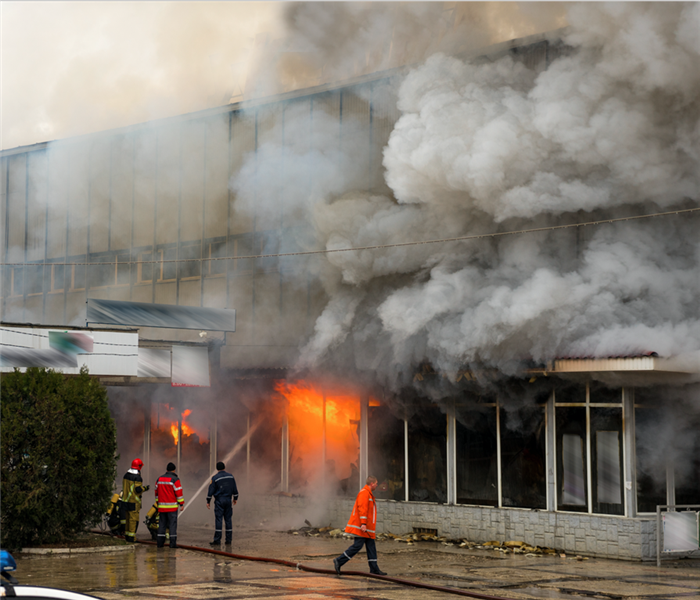 Fire and water damage in Kansas City, MO
Fire and water damage in Kansas City, MO
When you think of a fire, you probably consider water as the fastest, most effective way to put it out. Indeed, the right amount of water can make quick work of a blaze and reduce the amount of fire damage that could occur in your Kansas City, MO, office. But did you realize that while water is essential in fire suppression, it also can work against you? Because so much water is used to eliminate the flames, it's not uncommon for flooding and other related problems to ensue.
What Does It Hurt?
A fire in your place of business isn't something you want to think about ever happening. This disaster could cause harm and terrible damage in the workplace. While a fast-moving fire can quickly destroy parts of your building, water damage is often more gradual and even unnoticeable at first. Be aware of the following victims of flooding:
- Electronic equipment, including computers, printers and servers
- Furniture
- Documents, photographs, x-rays, blueprints
- Carpet
- Drywall
Built-in Sprinklers
A fire sprinkler system can be a wise investment for any business. This can be the first response to a blaze in the workplace and may help to get the incident under control before the fire crew even arrives. If you want to reduce the risk of fire damage, make sure you have a system and that it is in top-notch condition. However, these devices unleash a significant amount of water as soon as they sense a certain amount of heat. The volume of water coming from these sprinklers can ruin your floors and various materials.
Firefighting
The fire crew is essential to putting out the blaze, but each fire hose will put out as much as 500 gallons of water each minute. This can inflict tremendous damage to your office. While you're relieved the firefighters can eliminate the fire, their actions may require that you get in touch with a professional water removal company to help restore your office space.
Fire damage can be bad enough, but coupled with flooding, you face a big challenge. Make sure you call the pros to help you recover from these incidents.
4th of July Summer Safety Tips
6/24/2019 (Permalink)
 Celebrating the summer safely!
Celebrating the summer safely!
The 4th of July is one of the best times of the year in Missouri. Many people get together to celebrate freedom, friends, and food. Unfortunately, the holiday can also be dangerous due to different risks that are present. When trying to stay safe during the holiday, there are a few important safety tips to follow to protect yourself from harm.
Safety Tips
Handle Fireworks with Caution
To prevent injuries and fires that are caused by fireworks in the community, certain precautions should be taken. Never allow small children to get near fireworks or handle them. Adults should be the only ones lighting off the fireworks and should do so on the ground at a safe distance from trees or other objects. Keep a fire extinguisher close by and avoid lighting more than one firework at the same time.
Grill Safely
Grilling can also cause fires when you’re spending time flipping hamburgers and hot dogs outdoors. Look for leaks, holes, and cracks in the grill before you start using it on the 4th of July. Avoid grilling indoors or in an inclosed area. This can cause a fire to start and will lead to you to hire professionals such as SERVPRO of Raytown / East Kansas City to repair the damage. The grill should also be placed at least two feet away from the deck, branches, or the siding of the house.
Use a Pool Gate
Many people spend time in the pool cooling off from the warm temperatures in Missouri during the summer season. Keep it a safe activity by using a pool gate that will prevent children from getting into the water when they’re not supervised. Wireless outdoor sensors can also be installed to inform you if a child is near the pool. A first aid kit should also be on hand to tend to any injuries that can occur in the water. Kids should also use life jackets and floatation devices while swimming.
Practice Food Safety
Wash hands and clean the surfaces where you plan to prep food on the holiday. All meat should be cooked with a thermometer used to ensure that it reaches the right temperature to avoid food-borne illness. All leftovers should be refrigerated after two hours and not left outside. Toss out anything that sits outside for too long.
When trying to have a safe and memorable 4th of July, there are several safety practices to follow. With the right caution used, you can protect your family from harm and enjoy the day.
3 Things Homeowners Should Know About Natural Gas Fires
5/15/2019 (Permalink)
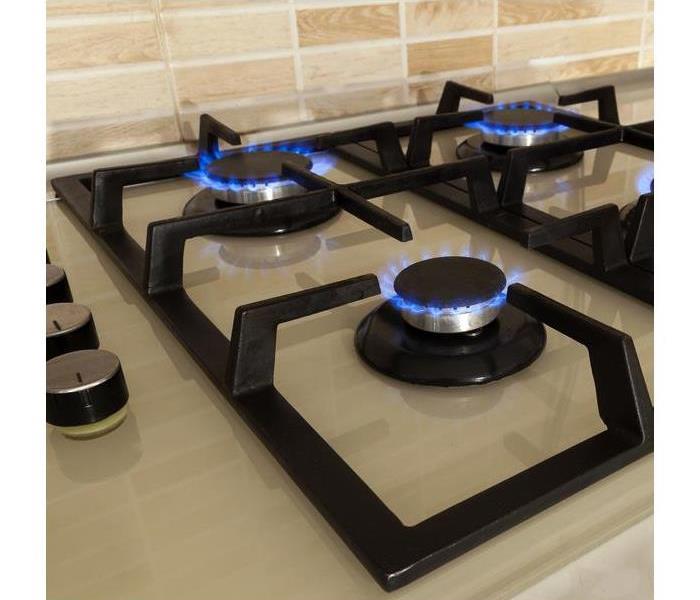 Being able to identify a gas leak can help you to prevent a fire from occurring in your home
Being able to identify a gas leak can help you to prevent a fire from occurring in your home
Learning About Natural Gas Fires
A home in Kansas City, MO, that experiences a gas fire can sustain catastrophic damage. Learning about natural gas fires can be helpful to homeowners who want to protect their homes.
1. The Signs of a Gas Leak
Being able to identify a gas leak can help you to prevent a fire from occurring in your home. One of the most common signs of a gas leak is the unpleasant odor that is often described as smelling like eggs. Hearing an unexplained hissing noise is also another common sign that your home may have a gas leak.
2. How To React
In addition to knowing the signs of a gas leak, it’s also helpful to know how to react if you suspect there is a gas leak in your home. If you think there may be a gas leak in your home, it’s generally wise not to turn on any lights or other appliances that use electricity, as they could spark a fire. In order to keep yourself safe if a gas fire does occur, it’s often important to evacuate your home and to call emergency services.
3. How To Avoid a Fire or Explosion
When a gas explosion or fire occurs, it’s often helpful to receive help from fire damage restoration experts. However, it’s generally best to prevent an explosion or fire rather than having to deal with the effects of a fire. In order to decrease the chance of a fire or explosion, it can be useful to turn off all appliances after using them. Additionally, it can be helpful to know where you gas meter is located in case the gas needs to be turned off in an emergency.
Knowing important information about natural gas fires can help homeowners feel more confident in their ability to keep their homes safe. It can be useful to know the signs of a gas leak, how to react if a leak does occur and how to prevent a gas fire or an explosion.
Why Choose SERVPRO Fire Restoration for your Raytown/East Kansas City Home
3/21/2019 (Permalink)
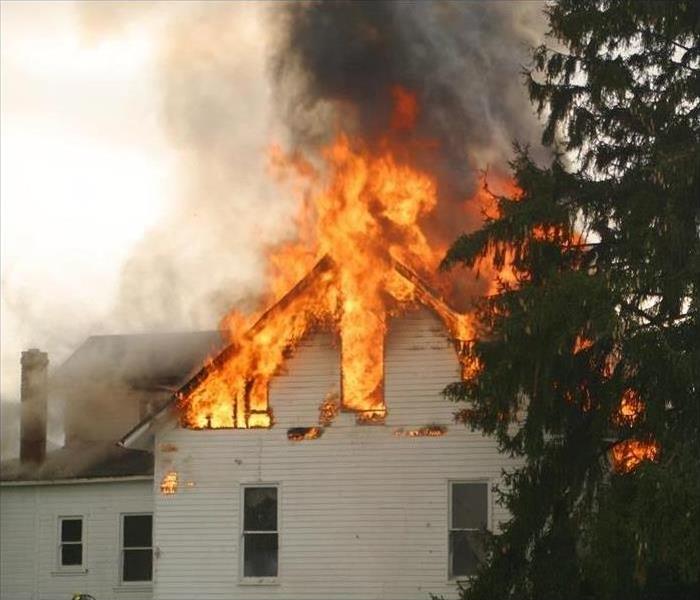 The professionals at SERVPRO can thoroughly clean smoke and odor residues left behind after a fire.
The professionals at SERVPRO can thoroughly clean smoke and odor residues left behind after a fire.
Fire Restoration
A fire in your Raytown/East Kansas City residence can leave you unsure of how to save the contents of your home and preserve its structural integrity. Most homeowners can concede that restoring the damage to their home is simply too great a task to handle on their own and choose to seek out reputable and experienced restoration professionals instead.
Finding the right professionals to handle the fire damage in your Raytown/East Kansas City residence boils down to which reputable company is willing to ensure that the job gets done safely, correctly, and above all else, efficiently. While there might be several options you can choose from, here are some considerations that might set our SERVPRO team apart.
Rapid response times help to mitigate damages that your home experiences even after a fire have gotten extinguished. This pre-emptive effort helps to keep overall restoration costs down and limits the amount of time the process takes overall. One of our SERVPRO mottos is to be Faster To Any Size Disaster, which is more than just a catchphrase.
Another process that sets our restoration team apart from some of the other options that exist for you to choose is our commitment to the contents of your house. We work quickly to determine at-risk items and remove them from the affected areas of your home for faster and more concentrated restoration efforts, but also to keep further damages from occurring to the items themselves.
These items get cleaned and deodorized individually, along with closer inspection to determine their need for restoration. Once the project nears completion in your home, these cleaned and restored individual items removed from your house get returned to their original positions.
There are many companies that you can choose from when it comes to fire restoration in your home. Our crew works to provide the best quality service encompassing the work that we do in your home and our commitment to providing the best in customer consideration. If you experience a fire in your home, trust our SERVPRO of Raytown/East Kansas City team to help you get things back to pre-damage condition. Give SERVPRO a call anytime at (816) 737-8776.
Stay Safe While Using Space Heaters
11/6/2018 (Permalink)
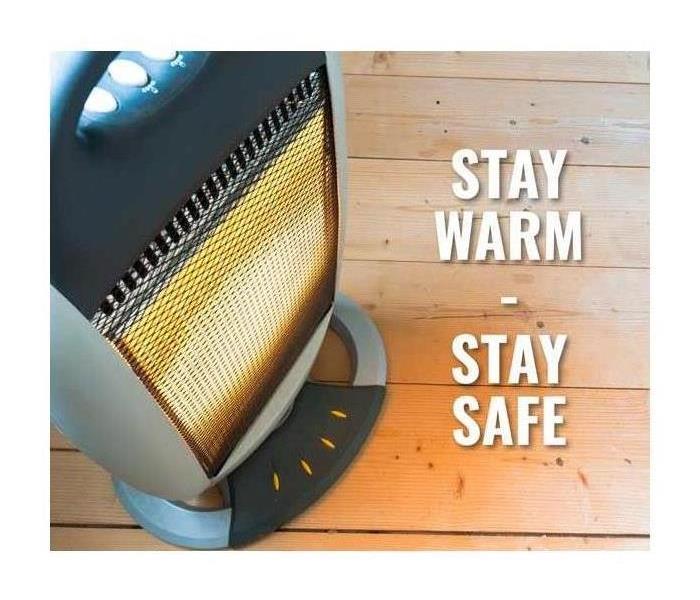 Be Mindful When Using a Space Heater. Keep Your Home Safe.
Be Mindful When Using a Space Heater. Keep Your Home Safe.
It's getting to be that time of the year where a space heater seems like the perfect appliance to make a room a little cozier.
Fire does not care what season it is or whether or not it’s cold outside. Cold weather related fires are extremely common, especially when you are trying to keep warm.
Our offices in Raytown/East Kansas City have experience in fire damage from space heaters and can provide you with some tips to help avoid having to deal with these types of destructive events this coming Autumn and Winter.
SERVPRO of Raytown/East Kansas City technicians understand that accidents happen. Placing space heaters too close to other objects or using the wrong type of heater in a particular area can cause severe problems. Please take a moment to consider some factors leading to these fires.
Oil Heaters - Should be used in areas where there is the possibility of moisture. This eliminates any electrical hazards that may be present due to water conductivity. Always keep a safe distance to avoid contact burns.
Electric Heaters - These heaters come in a variety of shapes and sizes and can be useful for many areas in your home. However, they should never be left unattended. Thinking of electric heaters as giant toasters can help you understand how important it is to keep a constant eye on them. Make sure you have sufficient wattage to run the device and never use extension cords.
Our SERVPRO of Raytown/East Kansas City staff gets an incredible amount of space heater-related calls every year when the weather gets to get chilly and blustery. People are trying to stay warm and use space heaters quite often for this purpose. However, using a space heater does not need to cause so many problems during a cold spell. Just use common sense, and always follow the directions of the manufacturer.
The professional technicians at SERVPRO of Raytown/East Kansas City state that you follow a few simple guidelines when operating your space heaters.
1) Always place space heaters on a flat, solid surface for proper stabilization.
2) Purchase heaters with an automatic shut-off feature to prevent dangers from tipping.
3) Maintain proper spacing between heaters and other objects in your home.
4) Never leave children or pets unsupervised around operating heaters.
5) Shut your heaters off properly before leaving your home or going to sleep.
Following these guidelines does not ensure that you will never have to deal with fire damage from space heaters. However, you are less likely to have an unwanted consequence. If this sort of incident still strikes your home this cold weather season, make the call to our offices at 816-737-8776 immediately. We will respond quickly and provide you with the services you need to get back to normal fast.
Methods for Removing Smoke Odor After a Fire
10/5/2018 (Permalink)
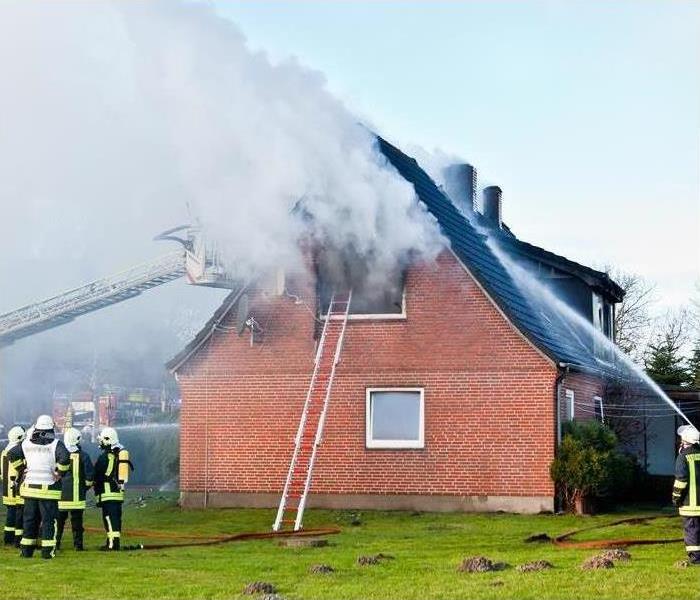 House Fire
House Fire
When you have a house fire in Raytown/East Kansas City, MO it may seem like the smell of the smoke will never go away. Smoke particles can infiltrate every nook and cranny in your home. They can even imbed themselves into furniture, flooring and walls. Professional restoration experts, however, have methods for extracting smoke odor from your home as part of the restoration process. Here are some smoke cleaning processes that may prove effective in removing the stench from your home.
Air Filtration Devices
One of the first methods the experts are likely to try is an air filtration device. This air scrubber sucks in the air in your home and returns it clean and refreshed. The filters in this system are specially constructed to reduce smoke odor. Some common features of filtration devices that remove smoke odor include
• HEPA filters
• Activated carbon filters
• Treated filters that specifically target smoke
Ozone Machines
Another method of smoke cleaning involves the use of ozone machines. Rather than taking air in, these machines create and expel ozone, the same compound chemical created by a rainstorm that gives the outdoor air its fresh scent. The ozone flows throughout your home, oxidizing smoke residue and neutralizing its odor.
Thermal Foggers
Thermal foggers create deodorizing droplets that permeate the air as well as porous materials in your home to get rid of smoke odor. Using heat and pressurization, the fogger creates tiny particles that can go wherever the smoke damage has gone. Your home is deodorized and cleansed of the stench of the fire.
One of the many advantages of hiring smoke cleaning professionals to remove odors from your home after a fire is that they are equipped with industrial machines that can be used to eliminate the smells. A process that would take weeks or even months with any device you could buy retail can be completed in a matter of hours or days with the advanced methods used by professionals.
Electrical Safety During a Flood
8/7/2018 (Permalink)
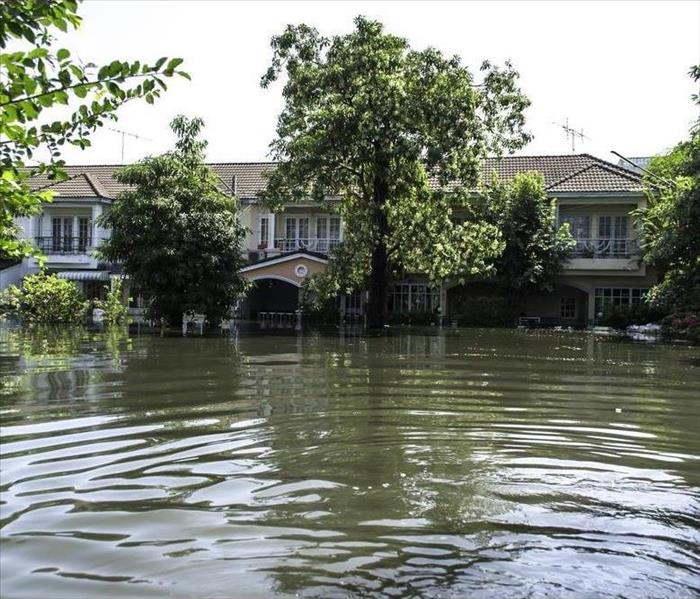 Some electrical damage can be a problem if you have a water damage in your home.
Some electrical damage can be a problem if you have a water damage in your home.
There are many risks associated with flooding. One of them is the danger associated with your electrical system. It is critically important to treat all electrical appliances, equipment and outlets with caution. Here are a few safety tips:
- Never step into standing water that has covered electrical outlets or devices-the water could already be charged with electric current.
- If there are downed power lines in your area, you should avoid them and notify your local power company.
- Avoid areas where there are sparks or if you hear popping or buzzing noises.
- If you smell something that resembles plastic burning, this could indicate an electrical fire.
After any flooding event, you should consult a certified electrician to determine the extent of damage to your electrical system.
How to Perform a Monthly Fire Extinguisher Inspection
7/27/2018 (Permalink)
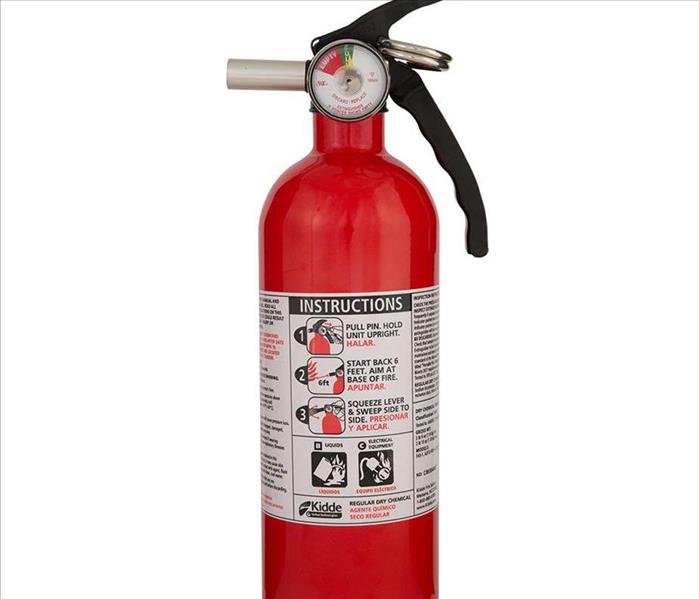 If you need professional fire, smoke and water damage cleanup and remediation after a fire, call the experts at SERVPRO of Raytown/East Kansas City.
If you need professional fire, smoke and water damage cleanup and remediation after a fire, call the experts at SERVPRO of Raytown/East Kansas City.
Home Safety: How to Inspect a Fire Extinguisher
When was the last time you took time to check the fire extinguisher that sits under your kitchen sink? Or the one hanging from a dusty hook in your garage? If you’re struggling to remember, it’s time to check it. Like any other piece of safety equipment, a home fire extinguisher should be inspected regularly to ensure it’s in proper working condition. A fire extinguisher in good working condition is your first line of defense when a home fire erupts.
Ideally, you should inspect your portable home fire extinguishers every month.
Tips for Performing a Monthly Fire Extinguisher Check
Check the label or tag.
Every fire extinguisher, whether disposable or rechargeable, has a manufacturer’s label or tag. Read the tag and follow the manufacturer’s recommended maintenance suggestions.
Check the tamper seal.
If the tamper seal has been broken or is cracked, a disposable fire extinguisher needs to be replaced. If it’s rechargeable, it needs to be serviced professionally. Check the locking or pull pin as well to make sure it’s in the correct position. If the pin missing, the fire extinguisher needs to be inspected or serviced by a professional.
Inspect for physical damage.
Physically inspect the fire extinguisher for obvious damage. This may include but is not limited to dents, corrosion, cracks and obvious leakage. If a fire extinguisher has leakage, it’s no longer under full pressure and may not work properly when you need it most. Check the fire extinguisher nozzle as well, to ensure it’s not clogged by grime, dust, bugs or leakage from the unit itself.
Check the pressure gauge.
Check that the pressure gauge needle indicates the fire extinguisher pressure is in the optimum operating range. Often the correct pressure range will be designated by green on the gauge.
Is the fire extinguisher full?
During your monthly check, lift the fire extinguisher and determine if it still feels full. If there has been a leak, it will feel light, and it won’t have the right amount of pressure to work correctly.
Shake it.
If you have a dry chemical fire extinguisher, it should be shaken once a month during your inspection. This helps prevent the chemical dousing agent from solidifying at the bottom of the unit.
Write inspection date on tag.
Keep track of every inspection date by writing it on the fire extinguisher tag.
Ensure easy access to your fire extinguisher.
Fire extinguishers should always be easy to access if there is an emergency. You don’t want to have to search for it once a fire breaks out. Don’t block fire extinguishers with furniture, boxes or any other items. Everyone who lives in the household should know where the closest fire extinguisher is located and how to use it in case of an emergency.
In the event of a fire emergency, first make sure to get people safely away, then call 911. A home fire extinguisher can be used to put out or control small fires, but it’s still safest to call professional fire fighters before you attempt to control a fire on your own.
How Professional Fire Damage Restoration Improves Your Business's Quick Recovery
7/25/2018 (Permalink)
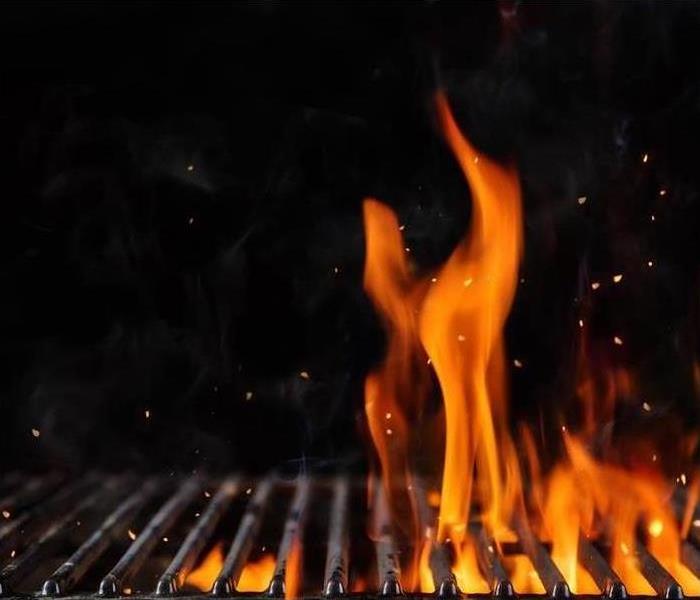 Count on SERVPRO after fire damage in your business.
Count on SERVPRO after fire damage in your business.
Recover after fire damage with the help of SERVPRO.
No business owner in Raytown/East Kansas City wants the focus for their clients or customers to be the company's ineffective recovery from a disaster. Keeping any damage from fire low key by trying to manage it in-house feels as though you retain control of both the recovery process and your brand. This benefits from this approach quickly become detriments when the challenges fire restoration derail your well-intentioned cleaning staff’s efforts. Involve our well-qualified and equipped fire damage crews to abate the effects fast and to health and restoration industry standards.
The fire damage in your Raytown/East Kansas City restaurant kitchen extinguished swiftly, but the damage is surprisingly pervasive. Smoke and soot are difficult to contain, especially when everyone involved concentrates on putting the fire out by any means possible. Concerns about the spread of fire residues assert after the fire department leaves. Our crews receive comprehensive training not only on basic cleaning at a fire site but also on a myriad of strategies to seek and halt migration of and remediate the non-combusted particles sent airborne during a conflagration.
Many restaurants use open layouts to connect diners to the magic occurring in the kitchen. With little blocking airflow, it is nearly impossible to stop fire residues from depositing on the tables, chairs, and flooring in your dining room. When SERVPRO’s crew arrives, we assess the extent of the fire damage apparent and plan to limit any further spread. If the majority of the damage is in the kitchen area, we can decide to set up a containment zone around the cooking area with heavy plastic sheeting and a negative pressure air scrubber system that prevents more residues from escaping into the spaces where your customers enjoy their meals. We use the walls and doors in place, but augment as needed to keep the spaces separated.
SERVPRO then matches the type of sooty residue with suitable cleaning tools and products. Kitchen fires are frequently protein based, laying down a thin but tenacious lacquer-like film that can require solvents to dislodge. We get to work in the containment chamber on the surfaces close to the fire center using techniques that minimize smearing and are appropriate for the damaged materials.
Meanwhile, in the parts of your restaurant further from the burning, we evaluate the type of soot and other residues that invaded before the establishment of the containment perimeter. SERVPRO technicians can vary the products, techniques, and tools if we encounter different types of residues. Lighter, ashy residues respond well to vacuums, dusting, and dry sponging. Stickier residues need the addition of cleaners with wetting agents and surfactants to loosen for wiping or scrubbing.
All spaces are likely to need deodorization, and SERVPRO employs cutting-edge technology to eliminate smells through chemical neutralization. Cover-ups like candles or air fresheners fail while our resources are broad and eventually remove the odors when our trained employees monitor the process, adjusting the methods until we achieve success.
All About Fires
3/20/2018 (Permalink)
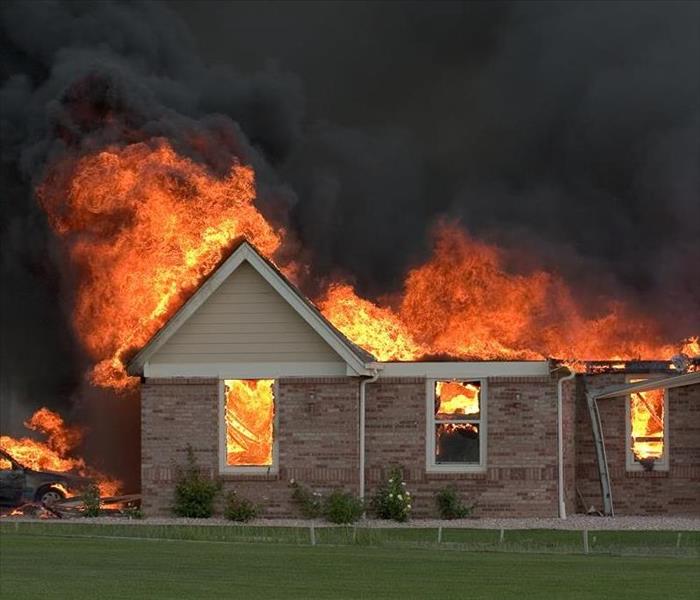 If you have a fire loss, call us - 816-737-8776
If you have a fire loss, call us - 816-737-8776
House fires are dangerous and can become life-threatening in just two minutes. It will only take 30 seconds for a small candle flame to engulf the window curtain and then create a thick black smoke that will fill your house. The smoke and gases are more deadly than the fire itself, so you must take extra precaution when you smell smoke.
Make sure you plan and create a fire escape plan and practice it with your family. Check your smoke alarms monthly to make sure the batteries are still working; working fire alarms increase your chance of survival.
If you do experience a fire, take these precautions:
- Crawl low under any smoke to your exit - heavy smoke and poisons gases collect first along the ceiling.
- Before opening a door, feel the doorknob and door. If either is hot, or if there is smoke coming around the door, leave the door closed and use your second way out.
- If you open a door, open it slowly. Be ready to shut it quickly if heavy smoke or fire is present.
- If you can’t get to someone needing assistance, leave the home and call 911 or the fire department. Tell the emergency operator where the person is.
- If the pets are inside your home, tell firefighters right away.
- If you can’t get out, close the door and cover vents and cracks around doors with cloth or tape to keep smoke out. Call 911 or your fire department. Say where you are and signal for help at the window with a light-colored cloth or a flashlight.
- If your clothes catch fire, stop, drop, and roll. If this is not possible, smother the flames with a blanket or towel. Use cool water to treat the burn immediately for 3 to 5 minutes. Cover with a clean, dry cloth.
Source: https://www.ready.gov/home-fires
Make sure you take precautions when you are cooking and smoking, or have portable space heaters and fireplaces to prevent those preventable house fires.
Top 5 Most Common Causes of House Fires
11/6/2017 (Permalink)
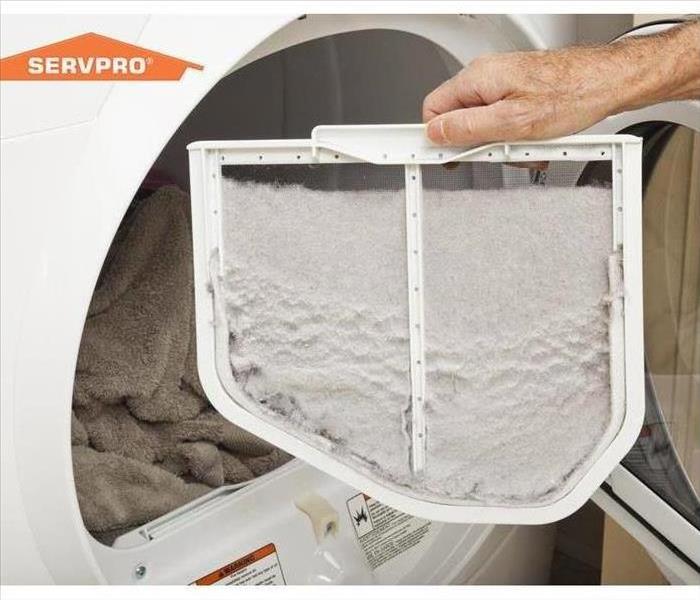 If you experience a fire in your home, don't hesitate to call SERVPRO of Raytown/East Kansas City at 816-737-8776
If you experience a fire in your home, don't hesitate to call SERVPRO of Raytown/East Kansas City at 816-737-8776
Here are top 5 most common causes of house fires as identified by the National Fire Protection Association.
- Candles
From 2007-2011, the NFPA says there were an average of 10,630 fires in the U.S. that were started by candles, causing 115 deaths, 903 injuries and approximately $418 million in property damage. That is an average of 29 candle fires per day.
Safety tips:
- Never leave a candle burning near flammable items.
- Never leave a candle burning in a child’s room or an unoccupied room.
- Make sure candles fit securing into candle holders so they won’t tip over.
- Blow out any candles before leaving a room or going to sleep
- Smoking
While the number of fires caused by smoking is trending downward, the NFPA found that there were still an average of 17,600 related fires per year resulting in 490 deaths and more than $516 million in property damage.
Safety tips:
- If you smoke, consider smoking outside.
- Use wide, sturdy ashtrays to catch butts and ashes.
- Look for cigarette butts under furniture and between seat cushions to make sure no lit butts have fallen someplace where they can’t be seen.
- Don’t smoke in bed, when you’re tired or around medical oxygen.
- Electrical & Lighting
According to the NFPA, in 2011 approximately 47,700 home structure fires were caused by some sort of electrical failure or malfunction. These resulted in 418 deaths, 1,570 injuries and $1.4 billion in property damage.
Safety tips:
- Don’t overload outlets or electrical cords.
- Make sure you have the right cord for the job – inside cords for inside, heavy duty/outside cords for outdoor use.
- Don’t leave Christmas lights, Christmas trees, or halogen lights on overnight or when not at home.
- Consider having an electrician perform an annual checkup of your home’s wiring.
- Dryers & Washing Machines
Clothes dryer fires happen more often than one might think, accounting for 16,800 home structure fires in 2010 and doing more than $236 million in property damage.
Safety tips:
- Clean the lint screen frequently and don’t run the dryer without it.
- For gas and propane dryers, make sure there aren’t any leaks in the lines.
- Vent the dryer to the outside of the house and ensure nothing blocks the vent pipe.
- Clean the vent pipe and the area where the screen is housed.
- Keep the area around the dryer free of combustible materials.
- Lightning
From 2007-2011, NFPA says there were an average of 22,600 fires per year caused by lightning strikes.
Safety tips:
- Stay away from doors and windows during an electrical storm.
- Do not use corded phones, computers, TVs or other electrical equipment during storms.
- Unplug major electronics – TVs, stereo equipment, computers and microwaves to minimize damage if there is a lightning strike close by.
- Avoid plumbing such as sinks, baths and faucets during a thunderstorm.
Preventing Puffbacks
10/6/2017 (Permalink)
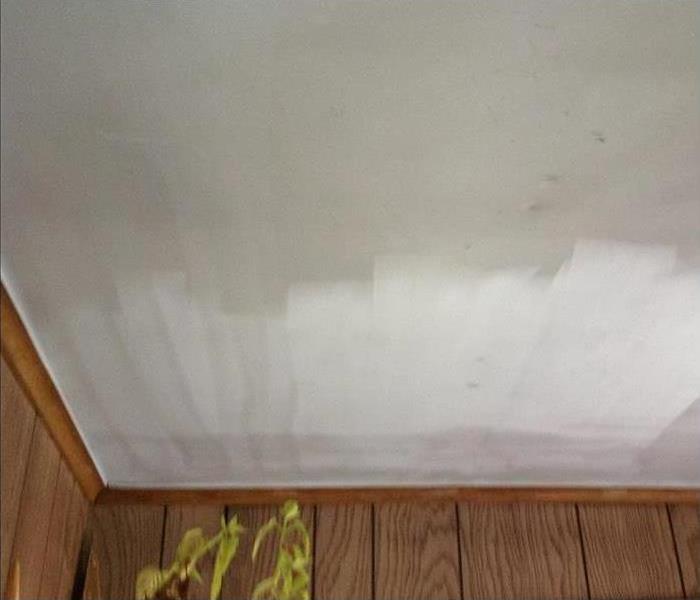 During the cleaning process after a puffback.
During the cleaning process after a puffback.
A puffback is a messy furnace malfunction that occurs when an oil burning furnace backfires, sending soot throughout the interior of a property. It can happen all at once, covering the interior in grimy soot, or it can leak soot more gradually.
Initially, many people mistake soot for dust and simply wipe it away. However, once cleaned, this “dust” often reappears and can sometimes be accompanied by a strong, oily odor. There are several steps you can take to prevent damage to your home:
- Have the oil-burning furnace professionally checked and cleaned annually.
- Keep an eye out for traces of soot around your home.
- Install a carbon monoxide monitor. Puffbacks (and the soot they create) will increase the carbon monoxide levels in your home. A carbon monoxide monitor can help to detect the puffback in its early stages.
If soot begins accumulating on objects or walls within your home, you should turn off the heating system immediately. Contact a heating professional to service the heater and restore it to proper working order. If the oil-burning furnace is left on it can carry it through the duct work to other portions of the home.
Fortunately, if you do experience a puffback, SERVPRO® has the knowledge and experience to complete a thorough cleaning and removal of any soot and odors. Depending on the severity we are able to perform a pack out to ensure your items are properly restored, cleaned, or removed for your safety and health.
Our Fire Restoration Team will respond immediately and give you the steps to ensure we can make it "Like it never even happened."
The Impact of Fire Damage on Your Property
8/8/2017 (Permalink)
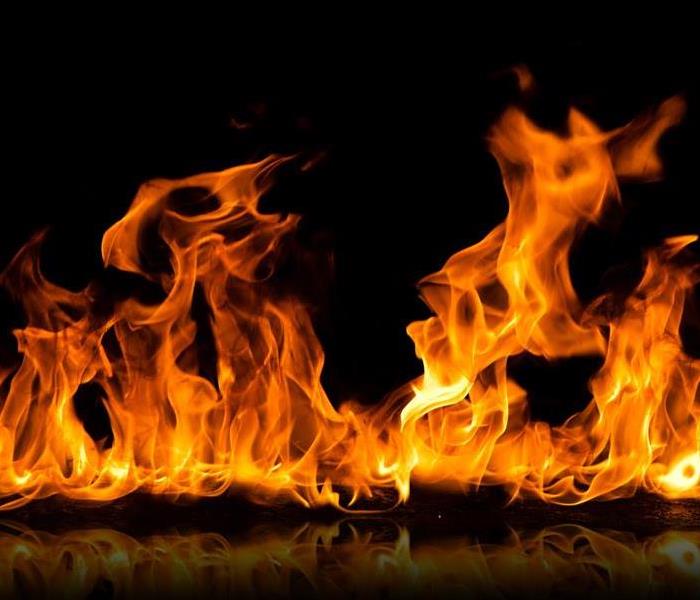 House fires cause unforeseen damage to your home.
House fires cause unforeseen damage to your home.
The Impact of Fire Damage on Your Property
Fire damage can have a detrimental impact on a person’s life. Whether there is a fire in home, or a fire in business, fire loss can be heart breaking. Soot damage and some damage can ruin so much of a person’s home. Not only is the fire itself terrible and devastating, but the actual fire cleanup can be awful as well. If a fire has recently occurred and caused commercial fire damage, or if the fire damage occurred die to a fire in home, this article is here to help you determine the best ways to address the aftermath.
First before any fire cleanup can occur it’s important to make sure that the fire in home or the fire in business is no longer a safety risk, especially if there was commercial fire damage. The local fire department can determine whether there is still a health risk in returning to cleanup the fire damage, the soot damage, or the smoke damage that has occurred. Fire loss is no laughing matter and should be addressed sagely and carefully.
Once you have had the notification that it’s now safe to enter your home to start the cleanup process, the actual soot damage, smoke damage, and amount of fire loss can be appraised. This can help to get the fire cleanup process settled so that you know the extent of the damage and make a plan to combat the fire damage. Before anything it’s important to stat ti our out the building, whether the damage was from a fire in home, or a fire in business. This will help the air quality and allow the prices of the cleanup of the soot damage or smoke damage to begin.
To start cleaning the soot damage and smoke damage it is absolutely crucial to make sure the air quality is fine before you begin, because too much smoke can have a detrimental impact on your heath. To begin this fire cleanup from the fire in home, fire in business, or commercial fire damage, you will need protective frat such as rubber gloves and eye protection. A bucket and spine will also be needed so that the soot damage can be scrubbed off from the walls. There are cleaning solutions that are available commercially to help you with this project. To make extra sure that the air quality is suitable it may be necessary to open a window. This is to ensure the air quality is not impacted by any apsidal smoke, and the air quality is not impacted by the cleaning agents being used.
After the walls have been cleaned the fire cleanup from other areas can being. Now the fire loss impact must be determined, and the items from the fire loss must be cleaned or discarded if they are beyond repair. This fire cleanup hopefully will not be too substantial, but it may be. If there is a large scale of destruction to may be a better idea to call professionals who can evaluate the damage and clean the mess for you. However, even if there was a fire in business or commercial fire damage you may be able to take care to the situation yourself be removing the soot form the commercial fire damage with a vacuum cleaner and rags.
Fire Escape Planning for Your Business
7/30/2017 (Permalink)
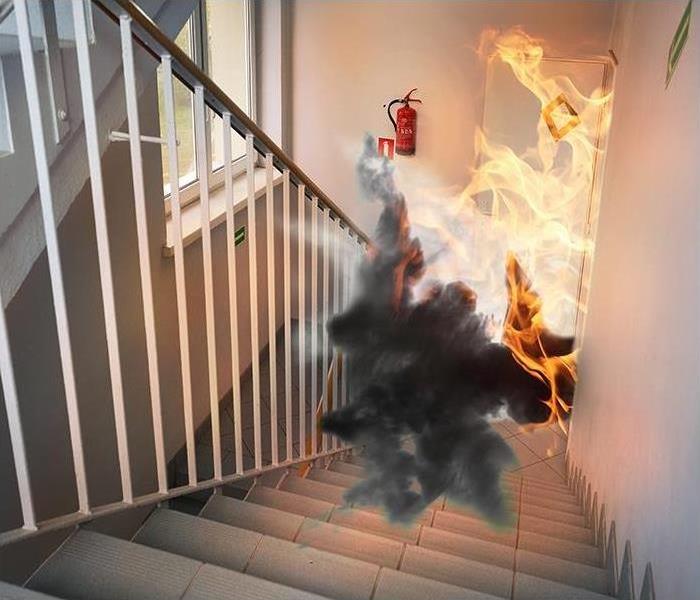 Are you prepared?
Are you prepared?
An emergency plan is not required for all businesses, however, OSHA recommends building an emergency action plan to protect yourself, your employees, and your business during an emergency. OSHA suggests the following steps when developing a plan.
Organize an Emergency Preparedness Procedures review with employees to review your company’s emergency plans. You may wish to select an individual or team of individuals to lead and coordinate your emergency plan.
Once a plan is developed, post evacuation procedures, including routes and exits, where they are easily accessible to all employees. Ensure all exits and routes are clearly marked, and well lit, wide enough to accommodate the number of evacuating personnel, and unobstructed and clear of debris at all times.
Conduct office evacuation exercises and drills. Designate a safe spot outside of the facility where employees can regroup, recover and conduct a head count. Once completed, evaluate how well the plan worked and if additional training or exercises are needed.
Turn and Test
7/24/2017 (Permalink)
 When in doubt, test it out!
When in doubt, test it out!
Great Advice from American Red Cross!
Did you know:
- Every day 7 people die in the United States due to a home fire
- You have two minutes- that 120 seconds – to escape a home fire
- On an annual average, the Ohio Buckeye Region of the Red Cross responds to over 3 home fires per day in our 45 counties!
The American Red Cross cares about your safety and encourages you to test your smoke alarms and replace your batteries as needed. This is a lifesaving action of our Home Fire Preparedness Campaign, which rallies communities across the country to protest people from these every day disasters. Don't ignore the beeping sound of batteries going dead on a fire alarm, take a few minutes and go change the batteries right away! Your safety is in your own hands!





 24/7 Emergency Service
24/7 Emergency Service



















